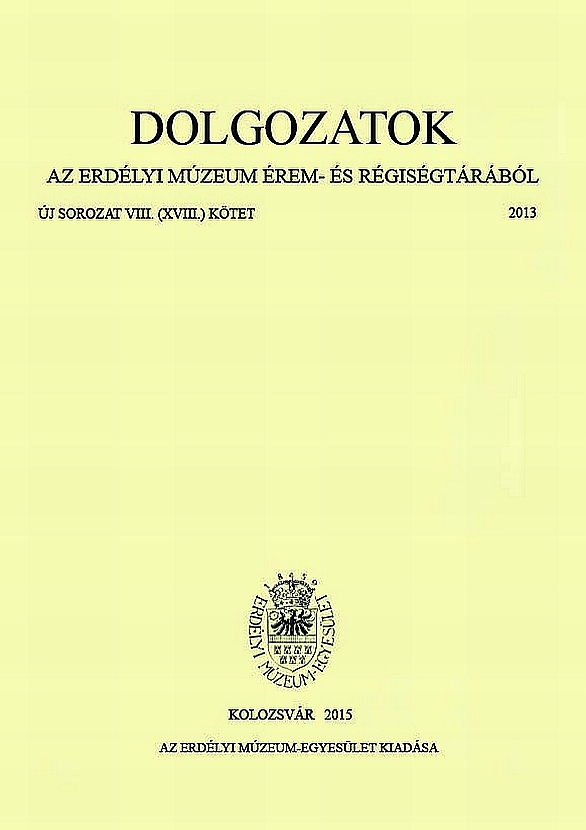Bánffy Miklós újabb arca – két serleg tükrében
A New Image of Miklós Bánffy in the View of Two Chalices
Author(s): Mária ViskySubject(s): Fine Arts / Performing Arts, Cultural history, Social history, Interwar Period (1920 - 1939)
Published by: Erdélyi Múzeum-Egyesület
Keywords: Miklós Bánffy; Lajos Pál; silversmith; art deco; Wiener Werkstätte
Summary/Abstract: Count Miklós Bánffy, the last male direct descendant of the Bánffy counts of Losoncz has been active in more than one fields of art, his works in literature, stage- and costume design are well known and appreciated. My study is aimed to shed light on this personality’s less known field of activity, presenting two parcel gilt silverworks designed by Bánffy and manufactured by silversmith Lajos Pál from Budapest, outstanding pieces of the Hungarian metalwork in the interwar period. One of the chalices figured at the 2012 ’Art Deco and Modernism – Home Design in Hungary 1920–1940’ titled exhibition at the Budapest Museum of Applied Arts as a piece of the museum’s collection, and its match, with a religious iconography, is still used at confirmation ceremonies in the Farkas Street Reformed Church, Kolozsvár (Cluj-Napoca, RO), in conformity with the donor count’s wish. The oeuvre of Miklós Bánffy stands for an artist who worked in several areas of the fine arts and followed the most recent tendencies. Known for being a writer of the The Transylvanian Trilogy and several other literary works, he was also a graphic artist, was involved in staging Bartók's works and was the owner of a famous herd. The aristocratic origin and upbringing of the count, his variety of experiences in Europe which helped him to become an influential figure of the political and cultural life in the Austro-Hungarian Monarchy and in Transylvania contributed to his artistic creations. From the Hungarian art deco artworks dating from the 20s and the 30s just a few remained, however these – including the two Bánffy chalices – are fine examples of the Hungarian art deco stream. The delicately decorated, harmoniously proportioned chalices are similar in both their shape and their execution, and bear witness to a craftsman with an exceptionally elaborate technique. Considering the unprocessed work of Lajos Pál, the School of Applied Arts’ former teacher and for a short time commissioned headmaster, these two silverworks presented a firm starting point in discovering the silversmith’s professional path. In the structural solutions of the works from 1931 the craftsman revives the traditional silversmith’s technique, the principle of assembling – which can be found already in the late gothic and in the mannerist metalwork. Furthermore they feature the embellishment of the interwar period’s applied arts, the use of elements of nature and of geometrical stylization. These fruits of Miklós Bánffy’s various and extensive oeuvre bear the signs of the count’s culture routed in his patrician literacy and the signs of his commitment to church and nature. The chalices’ importance lies in qualitative and thorough execution, and in the fact that they summarise the two artists’ most representative characteristics. Their style rooted in the Vienna Secession, the Wiener Werkstätte art and the centuries old silversmith practice all reflect the multitude of Pál’s typical inspirations. Meanwhile, the lightness of Bánffy’s design can be connected with the theatrical manner of the art deco style. In this period the theatre life and most importantly Diaghilev’s Russian ballet influenced heavily the graphic, the interior and the product design. This way, the elegant gestures and movements of the figural forms and the lightness of the elements from nature are both transferred to fine and applied arts, for which these chalices stand as good demonstrations. In conclusion, through their traditional concept and decorativeness they reflect the most significant characteristics of Lajos Pál’s art, and act as new testimonies of Bánffy’s creative versatility, good examples of the Transylvanian and Hungarian artistic awareness.
Journal: Dolgozatok az Erdélyi Múzeum Érem- és Régiségtárából. Új sorozat
- Issue Year: 2013
- Issue No: VIII
- Page Range: 171-184
- Page Count: 14
- Language: Hungarian

